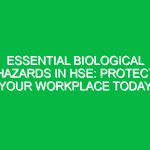Introduction
Welding is a critical process in various industries, from construction to manufacturing. However, it is accompanied by significant risks and Hazards that can impact the health and Safety of workers. Understanding weld and Safety within the context of Health, Safety, and Environment (HSE) is not just a regulatory requirement; it is a moral obligation to ensure a secure working environment. In this article, we will delve into essential Welding Safety tips that can help create a hazard-free workplace, discussing the importance of proper Safety Measures, potential risks associated with welding, and actionable insights for workers and employers alike.
Understanding Weld and Safety in the HSE Context
Weld and safety encompass the practices, procedures, and equipment used to protect workers from the risks associated with welding operations. These risks can range from physical injuries, such as Burns and cuts, to respiratory issues from inhaling harmful fumes. The HSE framework emphasizes the need for systematic approaches to mitigate these Hazards through Training, personal protective equipment (PPE), and adherence to regulatory Standards.
In the welding industry, safety is paramount. Statistics show that welding-related injuries account for a significant percentage of workplace accidents. Therefore, understanding the intricacies of weld and safety is essential for fostering a safe working environment and ensuring compliance with legal requirements.
Key Aspects of Welding Safety
1. Personal Protective Equipment (PPE)
One of the most critical components of weld and safety is the use of appropriate Personal Protective Equipment (PPE). This includes:
- Welding Helmets: Protect the eyes and face from harmful UV rays and sparks.
- Gloves: Provide protection against heat and sharp objects.
- Protective Clothing: Flame-resistant garments help reduce the risk of burns.
- Respirators: Essential for preventing inhalation of harmful fumes and gases.
Investing in high-quality PPE and ensuring it is worn correctly can significantly reduce the risk of injuries. For instance, a welder I spoke to once shared how a simple oversight—failing to wear gloves—led to a severe burn that sidelined him for weeks. This underscores the importance of not just having PPE but also using it consistently.
2. Proper Training and Certification
Understanding the welding process and safety protocols is crucial. Employers should ensure that all workers are adequately trained and certified in welding techniques and safety practices. Regular training sessions can help refresh knowledge and introduce new Safety Measures.
For example, a manufacturing company I worked with implemented a quarterly safety training program that significantly reduced accidents. Employees were encouraged to share their experiences and discuss safety protocols, fostering a culture of safety.
3. Safe Work Environment
Maintaining a clean and organized workspace is vital for welding safety.
- Clear Work Area: Remove clutter and ensure that the work area is free from flammable materials.
- Proper Ventilation: Ensure adequate ventilation to disperse harmful fumes.
- Proper Storage: Store gases and materials safely to prevent leaks and accidents.
A well-maintained workspace reduces the likelihood of accidents and enhances overall productivity. In one case, a welder tripped over scattered materials, resulting in a severe injury that could have been easily avoided.
4. Awareness of Hazards
Welders must be aware of the specific hazards associated with their work. These can include:
- Electrical Hazards: Risks of electric shock from faulty equipment or improper grounding.
- Fire Hazards: Sparks and heat can ignite flammable materials.
- Fume Exposure: Inhalation of toxic fumes can lead to respiratory diseases.
Regular hazard assessments and implementing Control Measures can mitigate these risks. For instance, using fire-retardant curtains can help contain sparks and prevent Fires in nearby areas.
Best Practices for Welding Safety
1. Pre-Weld Safety Checklist
Before starting any welding Operation, a safety checklist should be completed. This checklist can include:
- Inspecting equipment for damage or wear.
- Ensuring proper setup of PPE.
- Verifying the workspace is clear of hazards.
By following a pre-weld safety checklist, welders can catch potential issues before they escalate into accidents.
2. Communication and Signage
Effective communication is vital in any workplace. In welding operations, clear signage indicating hazards and safety protocols can serve as constant reminders for workers.
For example, using visual aids like signs that indicate the presence of flammable materials can enhance awareness and promote safety compliance. I once visited a workshop where safety signs were prominently displayed, leading to a noticeable reduction in near-miss incidents.
3. Emergency Preparedness
Being prepared for emergencies is crucial in welding environments.
- Fire Extinguishers: Ensure that fire extinguishers are readily available and easily accessible.
- First Aid Kits: Have well-stocked first aid kits on-site for immediate response to injuries.
- Emergency Procedures: Train employees on emergency response procedures, including evacuation routes.
One company I consulted for had regular drills that prepared employees for emergencies, leading to quicker response times in actual incidents.
Regulations and Standards Governing Welding Safety
Various Regulations govern welding safety, primarily focused on protecting workers from hazards. In the U.S., the Occupational Safety and Health Administration (OSHA) sets forth guidelines that employers must follow. These include requirements for PPE, ventilation, and training.
Additionally, the American National Standards Institute (ANSI) provides standards for welding operations that ensure Safe Practices are followed. For instance, ANSI Z49.1 outlines safety in welding, cutting, and allied processes, offering guidelines on everything from equipment safety to environmental considerations.
Compliance with these regulations not only safeguards workers but also protects employers from legal ramifications arising from workplace accidents.
Conclusion
Weld and safety are integral components of a healthy and secure workplace. By implementing proper safety measures, investing in training, and fostering a culture of safety, employers can significantly reduce the risks associated with welding operations. The importance of weld and safety extends beyond compliance with regulations; it reflects a commitment to protecting workers’ health and well-being.
As we navigate the complexities of welding in various industries, let us prioritize safety to create an environment where everyone can work without fear of injury. Emphasizing weld and safety not only enhances productivity but also promotes a sustainable and responsible approach to health, safety, and the environment. Whether you are a welder, an employer, or a safety officer, consider these essential safety tips as a roadmap to a hazard-free workplace.


